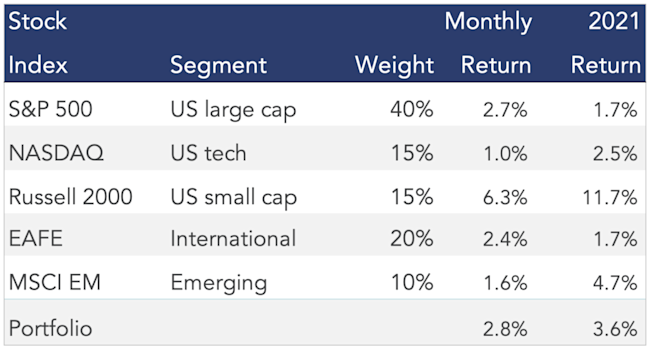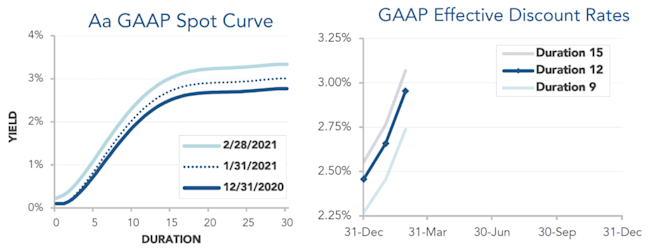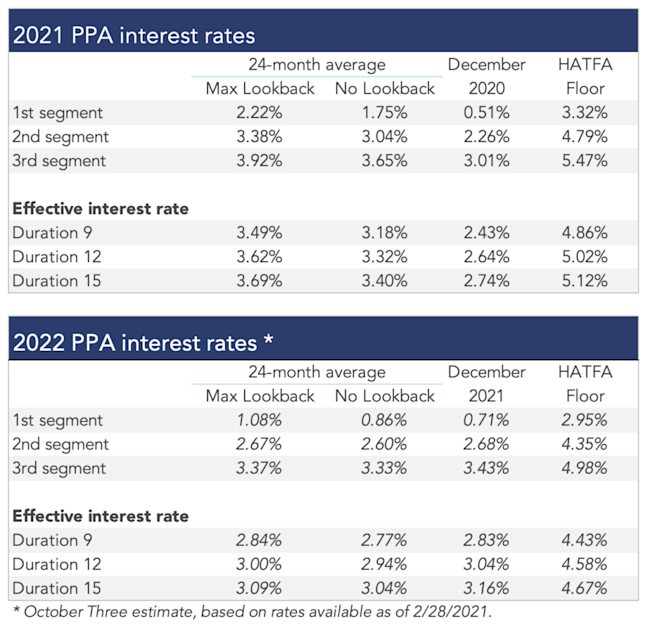
February 2021 Pension Finance Update
Pension finance enjoyed its best month in more than three years in February, buoyed by higher stock prices and higher interest rates.
Pension finance enjoyed its best month in more than three years in February, buoyed by higher stock prices and higher interest rates. Both model plans we track[1] gained ground last month: Plan A gained 5% and is now up more than 7% for the year, while the more conservative Plan B added 1% and is now up more than 1% through the first two months of 2021:

Assets
Stocks rose again last month, building on a modestly positive January. A diversified stock portfolio gained 2%-3% in February and is now up 3%-4% for the year:

Interest rates rose another 0.3% in February. As a result, bonds lost 2%-4% last month and are now down 3%-6% for the year, with long duration bonds performing worst.
Overall, our traditional 60/40 portfolio gained less than 1% during February and is even for the year, while the conservative 20/80 portfolio lost 2% in February and is now down more than 3% for the year.
Liabilities
Pension liabilities (for funding, accounting, and de-risking purposes) are driven by market interest rates. The first graph below compares our Aa GAAP spot yield curve at December 31, 2020 and February 28, 2021, and it also shows the movement in the curve last month. The second graph below shows our estimate of movements in effective GAAP discount rates for pension obligations of various duration during January:

Corporate bond yields moved up 0.3% in January and are now up 0.5% since the end of 2020. As a result, pension liabilities fell 3%-5% during the month and are now down 5%-8% for the year, with long duration plans seeing the largest declines.
Summary
Pension finance has enjoyed a boost in early 2021 due to a spike in interest rates along with higher stock markets. The graphs below show the movement of assets and liabilities through the first two months of 2021:

Looking Ahead
Pension funding relief has reduced required plan funding since 2012, but under current law, liabilities will increase substantially for 2021-2023. Plans that have only made required contributions in the past can expect significant increases in required contributions over the next couple years.
However, during January, Congress introduced pension funding legislation that would extend relief for several more years. The progress of this legislation will be crucial to pension decision-making in the months ahead.
Discount rates moved higher last month. We expect most pension sponsors will use effective discount rates in the 2.7%-3.2% range to measure pension liabilities right now.
The table below summarizes rates that plan sponsors are required to use for IRS funding purposes for 2021, along with estimates for 2022. Pre-relief, both 24-month averages and December ‘spot’ rates, which are still required for some calculations, such as PBGC premiums, are also included.

[1] Plan A is a traditional plan (duration 12 at 5.5%) with a 60/40 asset allocation, while Plan B is a largely retired plan (duration 9 at 5.5%) with a 20/80 allocation with a greater emphasis on corporate and long-duration bonds. We assume overhead expenses of 1% of plan assets per year, and we assume the plans are 100% funded at the beginning of the year and ignore benefit accruals, contributions, and benefit payments in order to isolate the financial performance of plan assets versus liabilities.
